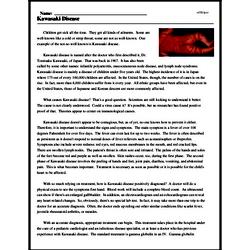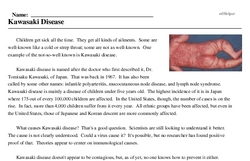Kawasaki Disease
Children get sick all the time. They get all kinds of ailments. Some are well-known like a cold or strep throat; some are not as well-known. One example of the not-so-well known is Kawasaki disease.
Kawasaki disease is named after the doctor who first described it, Dr. Tomisaku Kawasaki, of Japan. That was back in 1967. It has also been called by some other names: infantile polyarteritis, mucocutaneous node disease, and lymph node syndrome. Kawasaki disease is mainly a disease of children under five years old. The highest incidence of it is in Japan where 175 out of every 100,000 children are affected. In the United States, though, the number of cases is on the rise. In fact, more than 4,000 children suffer from it every year. All ethnic groups have been affected, but even in the United States, those of Japanese and Korean descent are more commonly affected.
What causes Kawasaki disease? That's a good question. Scientists are still looking to understand it better. The cause is not clearly understood. Could a virus cause it? It's possible, but no researcher has found positive proof of that. Theories appear to center on immunological causes.




